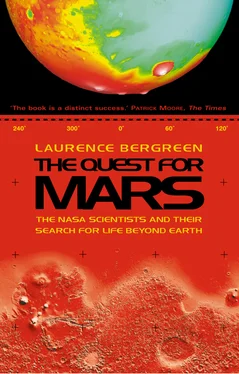By mid-afternoon, we reach a small research hut at the base of the volcano, where the Icelandic botanists who flew in with us have gathered. A pot of water comes to a boil on a little propane stove, a welcome sight, a bit of Earth on Mars. Over a mug of instant coffee, I converse with a botanist, Sturla Fridricksson, who, Jim explains, is considered the grand old man of Surtsey research. Sturla’s face has been seamed and cured to a leathery perfection by the Northern sun. He looks as though he’s served time on the Kon-Tiki . Just as he launches into a complete geological history of Surtsey, a saga in itself, the Icelandic Coast Guard returns to rescue us. Their helicopter touches down with a great throbbing racket; the rotors feel like they’re sucking the air right out of my nostrils. Silent and overwhelmed with impressions from our day’s exploration, Jim and I begin the journey back to the mainland, as though returning to Earth.
When he’s not climbing active volcanoes, Jim Garvin often roams the hallways at his place of work, NASA’s Goddard Space Flight Center in Greenbelt, Maryland. That was where we met, exactly one year earlier, when I was visiting a friend who also works there. Jim was standing in a busy corridor, holding forth on the subject of Mars, and within minutes, the sound of his voice attracted a crowd of curious scientists, who drifted away from whatever they were doing to listen. Somebody ought to be getting this down, I thought, and started to take notes as fast as I could. When we began to talk, he identified himself as a co-investigator for the Mars Global Surveyor (MGS), a state-of-the-art spacecraft designed to orbit Mars and conduct a number of pioneering experiments, including mapping the surface of the Red Planet in more detail than is available for Earth.
His special area of interest, he explained, is an instrument on MGS known as a laser altimeter – a laser designed to fire impulses at the surface of Mars. Minute fluctuations in the time it takes for the impulses to return create a three-dimensional picture of the surface, accurate to within a few meters. This is an incredibly intricate engineering feat – akin to extending a tape measure all the way from New York City to Washington, D.C., to determine the surface variations on the dome of the Capitol, while recording the results in a moving car back in New York.
At that first encounter, Jim invited me – as he does everyone he meets – to share his obsession with Mars. He is a rigorous scientist, but underneath the rigor lurks a romantic explorer. Mars is not just a planet to him; it holds, potentially, the answers to the riddles of the universe. At the time of this meeting, in July 1997, the Pathfinder spacecraft had just landed on the Red Planet, and its tiny rover, Sojourner Truth, had captured the imagination of the scientific community and people around the world, who were able to follow the extraterrestrial proceedings closely on the Internet. As I talked with Jim about the development of Mars exploration, it occurred to me that Pathfinder belonged to a much larger story – mankind’s exploration of Mars – and that the exploration was itself part of an even larger story: the search for the origins of life on Earth and throughout the universe.
Despite the sophistication of the new missions to Mars, Jim waxes nostalgic about the Viking program of the mid-70s – “the Cadillac of missions,” he says. “They actually had better equipment then.” Of course, it cost the American taxpayer about ten times as much as the current hardware does. He became involved with the Viking missions when he was still an undergraduate at Brown; a geology major, he helped to analyze images from the Viking 2 lander spacecraft, and he got hooked on the study of Mars. (Planetary spacecraft come in three basic varieties – flybys, landers, and orbiters. The flybys whiz past a planet on their way to somewhere else. An orbiter circles a planet. And a lander touches down on the surface.)
Just when he thought he’d found his vocation, the Viking missions ended, and NASA closed the book on Mars exploration. The missions, Jim often says, were the victims of their own success. They sent back thousands of stunning color images, and provided enough data to keep scientists occupied for two decades. They accomplished so much it seemed there was nothing left to do except send people to Mars, and there wasn’t enough money in the budget for that.
After graduation, Jim went to Stanford for an advanced degree in computer science. The life of a geek was not his style. So what if he could de-bug his colleagues’ programs and make them run faster? The work was too routine, too solitary, too stationary. He returned to Brown for his Ph.D. in geology, where he studied under Tim Mutch and Jim Head, who also taught a popular undergraduate course known as “Rocks for Jocks.” One day, Mutch said to Head, “You know, there are no fundamental problems left on Earth.” Mutch turned his attention to the planets and published an important – one is tempted to call it groundbreaking – book, The Geology of Mars , in 1976. This was a revolutionary idea, to study the geology of the Red Planet in a scientific manner. Geology claimed a gigantic new turf: the Solar System, and, by extension, planets and asteroids everywhere. All at once, geology became an integral part of the exploration of space, and Mutch was leading the way, training a new generation of planetary geologists, including Jim Garvin.
“At first glance,” Jim says, “Tim Mutch might have been perceived as a Jimmy Stewart type of character: tall, thin, amiable, and always above-board, almost self-deprecating. Deeper inside the man was his passion and resolve.” Occasionally, he’d remark to Jim, in an offhand way, “You’re a Mars person. Did you know that?” And at a party, he buttonholed his fast-talking young graduate student and said, “Jim, you and a few others are the future of Mars exploration, so it is yours to make it happen.” That was, he says, “heavy stuff” for a twenty-one-year-old grad student to hear.
As it happened, Brown played a role in analyzing data from the two Viking landers, so Jim had access to the latest developments in Mars research and analysis. He still revels in the memory as if it were his first love. It was his first love. In defiance of conventional geological practice, Mutch concentrated on the enigmatic landforms of Mars. “This was revolutionary thinking to me, as most geologists argue that studying typical landforms is the best way to learn how a surface was formed,” Jim says. “But Tim argued that finding those enigmatic landscapes might be more pivotal in the workings of Mars than background normal landscapes.”
In 1980, Tim Mutch led an expedition to the Himalayas. He made a successful ascent accompanied by two graduate students, but the weather turned foul during their descent. One of his crampons broke, and it was impossible for him to continue. The students wanted to carry him down, but he told them, “No way. Strap me in here. Go back to base camp and get help and come back for me.” By then, he might have been delirious from lack of oxygen. The students went down to base camp, and he probably thought they’d return in an hour to rescue him, but they had a rough time getting through the storm, and by the time they made it back, eight hours had passed, and there was no sign of Tim. His body was never found. The best guess is that the storm blew him off the mountain.
About a year later, Tim’s widow, Madeline, held a memorial gathering to which Jim was invited. She showed slides taken during her husband’s fatal descent. It was unbearably moving, especially for Jim, who had been Tim Mutch’s last graduate student. In an obscure but deeply felt way, Jim believed that as Mutch’s disciple, he was supposed to carry the torch – but where? He didn’t know, and even today, he still doesn’t know where, exactly, but he always hears Mutch’s voice in his ear, pointing the way to the Red Planet. And NASA was the only way to get there.
Читать дальше












